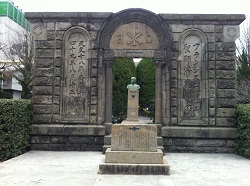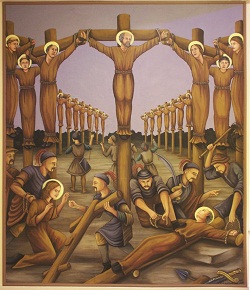The sight of the first Europeans to make landfall in Japan back in 1543 must have both bemused and bewildered the gawking Japanese. With their strange physique, and even stranger accouterments, it was indeed a sight to behold. The Portuguese brought not just their exotic wares, but the Christian faith through the Jesuits whose “God” is this Yaso (aka Jesus).
Yaso (Jesus) Who?
Christian century in Japan began with the arrival of Jesuit missionary, Francis Xavier, at Kagoshima on 15 August 1549. Through trade relationship and personal friendship with Portuguese, the powerful territorial lords in pre-modern Japan were quickly converting themselves to Christianity. Today, the original church stones is preserved in a memorial garden in Kagoshima.

“So do we carve another netsuke or better still, an okimono to represent this new god called Yaso?” – So the Japanese converts did in the flourishing but short period of Christian growth, primarily centered in Kyushu. But since then, Christianity has been severely stifled, with crucifixion the order of the day.
The Persecution Period
Christian faith spread throughout Kyushu rapidly. Many were baptized and the first Catholic hospital was open in 1557. It has been estimated that by the end of that century there were about 300,000 baptized believers in Japan.

In 1587 Toyotomi Hideyoshi, the all powerful warrior general and politician, banished Christian missionaries from Kyushu in his effort to unify Japan. In February 1597, he executed 26 Christians by public crucifixion in Nagasaki. They included Franciscan missionaries, Japanese Jesuits and Japanese laymen, including 3 young boys. They are known as the Twenty-six Martyrs of Japan.
Years Of Isolation
As persecution of Christians was increasingly brutal, Christians in Japan had no choice but to apostatize. Some lived in exile outside Japan while some escaped to remote regions where they could continue practicing Christianity in secret. Those who chose the latter course came to be known as kakure kirishitan and they continued to practice their religion for over two centuries.
Between mid 1600s to mid 1800s, Christians in Japan were persecuted as the central government considered Christian territorial lords in Kyushu as threat to unification. Christianity was not practiced
in Japan during this period of isolation.
Brief Opening Years
After Japan opened its doors to the West in 1853, many Christian clergymen were sent to Japan from Catholic, Protestant, and Orthodox churches. When religious freedom was restored after the Meiji Restoration in 1871, approximately 30,000 underground Christians came forward. A translation of the New Testament was completed in 1880, and of the Old Testament in 1887.
During the late 1800s, missionaries flocked to Japan and church membership multiplied rapidly. The desire to learn English attracted many young Japanese to Christian schools. However, this was quickly followed by renewed suspicion and rejection from the military government. Church growth slowed dramatically in the early twentieth century.
Juxtaposed – Shrine And Church
There were increasing Christian activities and influence during post-World War years. The Japanese conquerors of Singapore back in World War renamed Singapore “Syonan-To” ie “Light of the South.” And they even built a Shinto Shrine located in the forest of MacRitchie Reservoir, named “Syonan Jinja” i.e. Light of the South Shrine, with plans for it to be second only to the revered Meiji Shrine in Japan.
How prophetic. God is using us in Singapore to be the lamp upon which His light shines forth into the darkness encapsulating Japan. Today, there are no restrictions on evangelism or preaching gospel in Japan. Nevertheless, Japan remains largely unresponsive to Christian teaching. About 70% of all churches have an average attendance of less than 30, though membership is double this figure. May we continue to walk this wonderful journey of faithful servanthood in reaching this ripening spiritual field.
